- Home
- Sue Grafton
W Is for Wasted km-23
W Is for Wasted km-23 Read online
W Is for Wasted
( Kinsey Millhone - 23 )
Sue Grafton
Two dead men changed the course of my life that fall. One of them I knew and the other I’d never laid eyes on until I saw him in the morgue.
The first was a local PI of suspect reputation. He’d been gunned down near the beach at Santa Teresa. It looked like a robbery gone bad. The other was on the beach six weeks later. He’d been sleeping rough. Probably homeless. No identification. A slip of paper with Millhone’s name and number was in his pants pocket. The coroner asked her to come to the morgue to see if she could ID him.
Two seemingly unrelated deaths, one a murder, the other apparently of natural causes.
But as Kinsey digs deeper into the mystery of the John Doe, some very strange linkages begin to emerge. And before long at least one aspect is solved as Kinsey literally finds the key to his identity. “And just like that,” she says, “the lid to Pandora’s box flew open. It would take me another day before I understood how many imps had been freed, but for the moment, I was inordinately pleased with myself.”
In this multilayered tale, the surfaces seem clear, but the underpinnings are full of betrayals, misunderstandings, and outright murderous fraud. And Kinsey, through no fault of her own, is thoroughly compromised.
W is for . . . wanderer . . . worthless . . . wronged . . .
W is for wasted.
ALSO BY SUE GRAFTON
Kinsey Millhone Mysteries
A is for Alibi
B is for Burglar
C is for Corpse
D is for Deadbeat
E is for Evidence
F is for Fugitive
G is for Gumshoe
H is for Homicide
I is for Innocent
J is for Judgment
K is for Killer
L is for Lawless
M is for Malice
N is for Noose
O is for Outlaw
P is for Peril
Q is for Quarry
R is for Ricochet
S is for Silence
T is for Trespass
U is for Undertow
V is for Vengeance
and
Kinsey and Me: Stories
For Margo and Jeff Barbakow
and
Terri and Steve Bass.
Friends forever . . . and that’s what it’s all about.
ACKNOWLEDGMENTS
The author wishes to acknowledge the invaluable assistance of the following people: Steven Humphrey; Judge Brian Hill, Santa Barbara Superior Court; John Mackall, Attorney at Law, Seed Mackall LLP; Ted Steinbock, M.D.; Chief of Police Cam Sanchez, Senior Forensic Technician Michael Uullemeyer, Administrative Specialist Thalia Chaltas, Sergeant Dave Henderson, and Detective Gregory Hons of the Santa Barbara Police Department; Robert Failing, M.D.; Larry Gillespie; Florence Michel; Ken Ralph and Mike Foley, Casa Esperanza Homeless Center; Renee Burdick, American Express Travel; Brian Robertson and Heather Schuyler, Robertson International Travel; David Dyne, M.D.; Dana Hanson, funeral director, the Neptune Society; Director Donald Miller, M.D.; Associate Professor of Medicine Brian Clem, and Research Technologist II Miriam Reynolds, James Graham Brown Cancer Center, Louisville, Kentucky; Supervisor Christine Estrada, Lead Clerk Dolores Buendia, Judicial Assistants Kimberlee Taylor and Victoria Stuber, Santa Barbara Superior Court Records; Denyse Avila, Superior Court Clerk’s Office; Employee Benefits Manager Melissa Jammer and Customer Service Manager Barbara Allcock, Anderson Financial Services; Wayne Palmer; Terri Lang; Jeanie Purcell Hill; and Dale Charpentier.
And a special thank-you to Alice Hildreth Fix for the use of her name.
PROLOGUE
Two dead men changed the course of my life that fall. One of them I knew and the other I’d never laid eyes on until I saw him in the morgue. The first was Pete Wolinsky, an unscrupulous private detective I’d met years before through Byrd-Shine Investigations, where I’d served my apprenticeship. I worked for Ben Byrd and Morley Shine for three years, amassing the six thousand hours I needed for my license. The two were old-school private eyes, hard-working, tireless, and inventive. While Ben and Morley did business with Pete on occasion, they didn’t think much of him. He was morally shabby, disorganized, and irresponsible with money. In addition, he was constantly pestering them for work, since his marketing skills were minimal and his reputation too dubious to recommend him without an outside push. Byrd-Shine might subcontract the odd stretch of surveillance to him or assign him a routine records search, but his name never appeared on a client report. This didn’t prevent him from stopping by the office without invitation or dropping their names in casual conversations with attorneys, implying a close professional relationship. Pete was a man who cut corners and he assumed his colleagues did likewise. More problematic was the fact that he’d rationalized his bad behavior for so long it had become standard operating procedure.
Pete Wolinsky was gunned down the night of August 25 on a dark stretch of pavement just off the parking lot at the Santa Teresa Bird Refuge. The site was right across the street from the Caliente Café, a popular hangout for off-duty cops. It might seem odd that no one in the bar was aware that shots were fired, but the volume on the jukebox exceeds 117 dB, roughly the equivalent of a gas-powered chainsaw at a distance of three feet. The rare moments of quiet are masked by the high-pitched rattle of ice cubes in dueling blenders where margaritas are whipped up at a rate of one every four and a half minutes.
Pete’s body might not have been discovered until daylight if it hadn’t been for an inebriated bar patron who stepped into the shadows to take a leak. I heard about Pete’s death on the morning news while I was eating my Cheerios. The TV set was on in the living room behind me, more for the company than the content. I caught his name and turned to catch a night shot of the crime scene blocked off by yellow tape. By the time the news crew had arrived, his body had been loaded into the ambulance in preparation for transport to the coroner’s office, so there was really nothing to see. In the harsh glare of artificial light, a somber female reporter recited the bare facts. Pete’s immediate family must have been notified by then or she wouldn’t have mentioned him by name. Pete’s death was a surprise, but I can’t say it was a shock. He’d often complained of sleeping poorly and had taken to wandering the streets at all hours. According to the reporter, his wallet had been stolen along with his watch, a knock-off Rolex with a faux-platinum band. I guess robbers these days can’t distinguish the genuine article from the fake, which meant that Pete’s death wound up being more about impulse or cheap thrills than profit. He was a man with a propensity for risk, and it was only a matter of time before Lady Luck caught up with him and pushed him off the cliff.
The story about the second dead man is more complex and takes longer to articulate, especially since the facts emerged slowly over a matter of weeks. The coroner’s office called me on a Friday afternoon, asking if I could ID a John Doe who had my name and phone number on a slip of paper in his pocket. How could I resist? Every good mystery takes place on three planes—what really happened; what appears to have happened; and how the sleuth, amateur or professional (yours truly in this case), figures out which is which. I suppose I could put everything in perspective if I explained how it all turned out and then doubled back to that phone call, but it’s better if you experience it just as I did, one strange step at a time.
This was October 7, 1988, and it looked like things were as bad as they were going to get. On the national front, congressional spending was a whopping $1,064.14 billion and the federal debt was topping out at $2,601.3 billion. Unemployment hovered at 5.5 percent and the price of a first-class postage stamp had jumped from twenty-two cents to twenty-five.
I tend to disregard issues over which I have no control. Like it or not, the politicians don’t consult me about economic policies, budget cuts, or the gross national product, whatever that is. I might voice an opinion (if I had one), but as nearly as I can tell, nobody pays the slightest attention, so what’s the point? My only hope is to be the master of my own small universe, which is centered in a Southern California town ninety-six miles north of Los Angeles.
My name is Kinsey Millhone. I’m a private investigator, female, age thirty-eight. I rent office space in a two-room bungalow with a kitchenette and a bathroom on a narrow side street in the heart of Santa Teresa, population 85,810, minus the two dead guys. Since I’m the sole proprietor and lone employee, I operate on a modest scale, supporting myself by doing missing-persons searches, background checks, witness location, and the occasional service of process. From time to time I’m hired to establish paper trails in legal, financial, or property disputes. On a more personal note, let me say that I believe in law and order, loyalty, and patriotism—old-fashioned values that might seem woefully out of date. I also believe in earning an honest living so I can pay my taxes, cover my monthly bills, and tuck any surplus into my retirement account.
When I reached the coroner’s office, I was ushered into a bay with the curtain discreetly pulled around the ceiling track. Though curious, I wasn’t apprehensive. I’d done a quick survey and could account for the people I knew and loved. There were those who orbited my world in a wider gyre, but I couldn’t think of one whose death would have had a significant impact.
The dead man was stretched out on a gurney with a sheet pulled up to his chin, so there was nothing of an intimate nature in evidence. He was not someone I recognized. His skin tones were gray, underlined with a pale gold that suggested liver issues of a profound and possibly fatal nature. His features had been softened and flattened in death, angles worn as smooth as stone over which water has poured for thousands of years. The human spirit does more than animate the face; it lends character and definition. Here, there was none.
The decedent (to use the official term) appeared to be in his early seventies, white, and overweight in the manner of those who forgo their nine servings of fresh fruits and vegetables per day. Judging by the bulbous nose and broken veins across his weather-darkened face, he’d enjoyed alcohol in sufficient quantities to pickle the average adult. Sometimes the dead seem to sleep. This man did not. I studied him at length, and there was not even the faintest suggestion that he was breathing. Whatever spell had been cast over him, the effects were permanent.
His body had been discovered that morning in a sleeping bag on the beach where he’d hollowed out a place for himself in the sand. His campsite was just below a bank of ice plant that flourished between the bike path and the beach itself, a spot not immediately visible to passersby. During the day, the area is popular with the homeless. At night, the fortunate among them secure bed space at one of the local shelters. The unlucky ones are left to flop where they can.
The beachside park closes thirty minutes after sunset and doesn’t open again until 6:00 A.M. According to Municipal Code 15.16.085, it’s unlawful to sleep in any public park, public street, public parking lot, or any public beach, which doesn’t leave much in the way of open-air habitats available free of charge. The ordinance is designed to discourage transients from sacking out on the doorsteps of area businesses, thus forcing them to set up makeshift quarters under bridges, freeway overpasses, bushes, and other places of concealment. Sometimes the police roust them out and sometimes they look the other way. Much of this depends on whether the local citizens are feeling righteous about the poor or indifferent, as is usually the case.
Preliminary examination suggested the man had been dead for close to eighteen hours by the time the coroner’s investigator got in touch with me. Aaron Blumberg had been hired by the Santa Teresa County Coroner’s Office in the mid-’70s, just about the time I left the Santa Teresa Police Department and went to work for Ben Byrd and Morley Shine. The year I opened my office, Aaron was recruited by the Kern County Sheriff’s Department, from which he’d recently retired. Like many law-enforcement junkies, he was ill suited for a life of leisure, and he’d returned to the local coroner’s office some six months before.
He was a man in his sixties with a softly receding hairline. The top of his head was covered with gray fluff, like the first feathering out of a baby bird. His ears were prominent, his cheekbones pronounced, and his smile created long creases that bracketed his mouth like a marionette’s. We stood in silence for a moment and then he checked my reaction. “You know him?”
“I don’t. I take it he was homeless.”
Aaron shrugged. “That’s my guess. A group of them have been congregating in that grassy patch across the street from the Santa Teresa Inn. Before that, they camped in the park adjacent to the municipal swimming pool.”
“Who called it in?”
He took off his glasses and polished one lens with the end of his tie. “Fellow named Cross. Seven o’clock this morning, he was out on the beach with a metal detector sweeping for coins. He had his eye on the sleeping bag, thinking it had been dumped. Something about it bothered him, so he went out to the street and flagged down the first black-and-white that came by.”
“Was anyone else around?”
“The usual posse of bums, but by the time the paramedics arrived, they’d all drifted away.” He checked his lenses for smears and then resettled the glasses on his nose, tucking a wire stem carefully behind each ear.
“Any signs of foul play?”
“Nothing obvious. Dr. Palchek’s on her way out. She has two autopsies on the books, which puts this guy at the end of the line, pending her assessment. Since Medicare went into effect, she doesn’t do a post on every body brought in.”
“What do you think he died of? He looks jaundiced.”
“Not to be flip about it, but what do any of these guys die of? It’s a hard life. We have one just like this every couple of months. Guy goes to sleep and he never wakes up. Could be hepatitis C, anemia, heart attack, alcohol poisoning. If we can ID the guy, I’ll canvas the local clinics in hopes he’s seen a doc sometime in the last twenty days.”
“No ID at all?”
Aaron shook his head. “Note with your name and phone number and that was it. I inked his fingers and faxed the ten-print card to the DOJ in Sacramento. Weekend’s coming up and those requests are going to sit there until somebody gets around to ’em. Might be the middle of next week.”
“Meanwhile, what?”
“I’ll check his description against missing-persons reports and see if there’s a match. With the homeless, their families sometimes don’t care enough to fill out the paperwork. Of course, it works the other way as well. Street people don’t always want to be located by their so-called loved ones.”
“Anything else? Moles, tattoos?”
He lifted the sheet to expose the man’s left leg, which was shorter than his right. The knee cap was misshapen, raised in a thick knot like a burl. The flesh along the fibula was laced with red ropes of scar tissue. At some point in the past, he’d suffered a devastating injury.
“What happens if you never find out who he is?”
“We’ll hold him for a time and then we’ll bury him.”
“What about his effects?”
“Clothes on his back, sleeping bag, and that’s it. If he had anything else, it’s gone now.”
“Ripped off?”
“That’s possible. In my experience, the beach bums are protective of one another, which is not to say they might not confiscate the stuff he had no further use for.”
“What about the note he carried? Can I see it?”
He reached for the clipboard at the bottom of the gurney and freed the clear plastic evidence bag in which the slip had been placed. There was a picket fence of torn paper along the top, the leaf apparently ripped from a spiral-bound pad. The note was written in ballpoint pen, the letters unif
orm and clean: MILLHONE INVESTIGATIONS with the address and phone. It was the sort of printing I’d emulated in the fourth grade, inspired by a teacher who used a mechanical pencil and the same neat hand.
“That’s my office,” I remarked. “He must have looked me up in the yellow pages. My home number’s unlisted. Wonder what a homeless guy wanted with a PI?”
“I guess they’ve got problems just like everyone else.”
“Maybe he thought I’d come cheap since I’m a girl.”
“How would he know that? Millhone Investigations is gender neutral.”
“Good point,” I said.
“At any rate, I’m sorry for the wasted trip, but I thought it was worth a shot.”
“Absolutely,” I said. “Do you mind if I ask around? Somebody must know who he was. If the guy needed help, he might have confided in his cronies.”
“Do anything you want as long as you keep us in the loop. Maybe you’ll find out who he is before we do.”
“Wouldn’t that be nice?”
• • •
I sat for a moment in the parking lot, jotting notes on a succession of index cards that I keep in my bag. There was a time when I trusted more to memory. I was raised by a maiden aunt who believed in rote learning: multiplication tables, state capitals, the kings and queens of England and their reigns, religions of the world, and the periodic table of elements, which she taught me by the judicious arrangement of cookies decorated with blue, pink, yellow, and green frosting, numbers piped onto each in a contrasting color. Oddly enough, I’d forgotten that particular exercise in child abuse until the previous April, when I walked into a bakery and saw a display of Easter cookies. In a flash, like a series of photographs, I saw hydrogen, atomic number 1; helium, atomic number 2; lithium, atomic number 3, working my way as far as neon, atomic number 10, before my mind went blank. I am still able to recite long portions of Alfred Noyes’s “The Highwayman” at the slightest provocation. In my experience, this is not a useful skill.

 S Is for Silence
S Is for Silence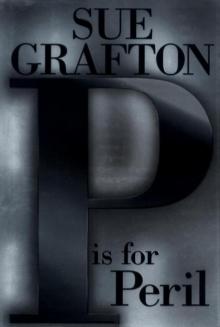 P Is for Peril
P Is for Peril R Is for Ricochet
R Is for Ricochet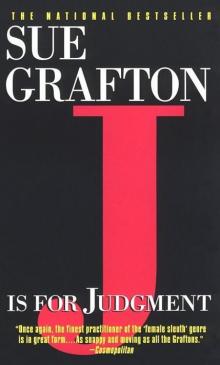 J Is for Judgment
J Is for Judgment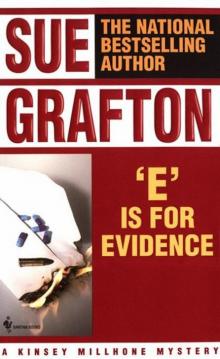 E Is for Evidence
E Is for Evidence T Is for Trespass
T Is for Trespass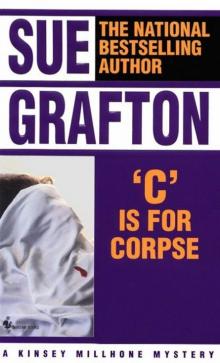 C Is for Corpse
C Is for Corpse U Is for Undertow
U Is for Undertow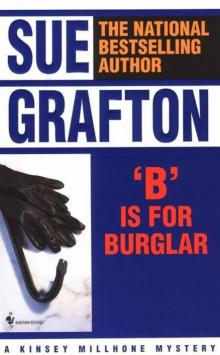 B Is for Burglar
B Is for Burglar Four Sue Grafton Novels
Four Sue Grafton Novels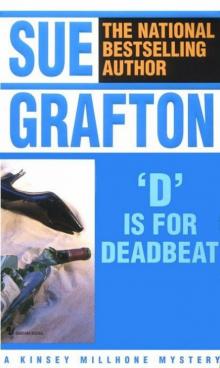 D Is for Deadbeat
D Is for Deadbeat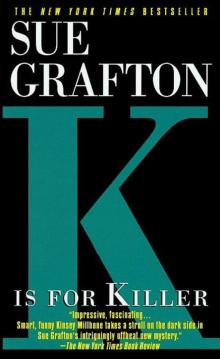 K Is for Killer
K Is for Killer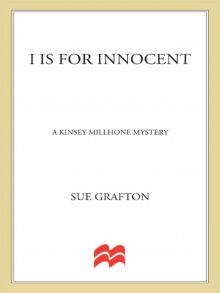 I Is for Innocent
I Is for Innocent A Is for Alibi
A Is for Alibi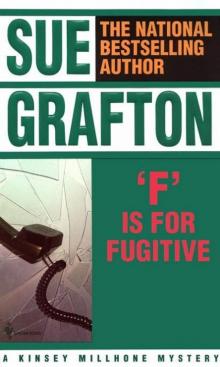 F Is for Fugitive
F Is for Fugitive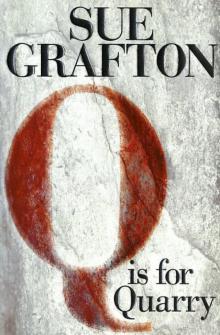 Q Is for Quarry
Q Is for Quarry W Is for Wasted
W Is for Wasted Kinsey and Me: Stories
Kinsey and Me: Stories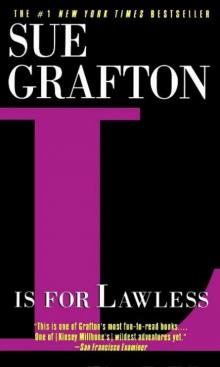 L Is for Lawless
L Is for Lawless Y Is for Yesterday
Y Is for Yesterday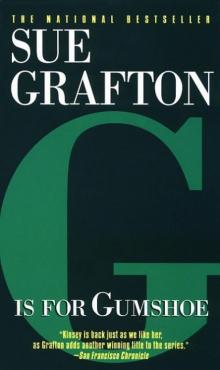 G Is for Gumshoe
G Is for Gumshoe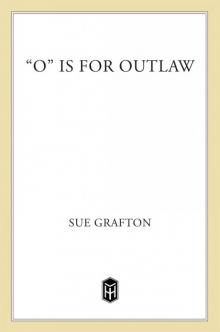 O Is for Outlaw
O Is for Outlaw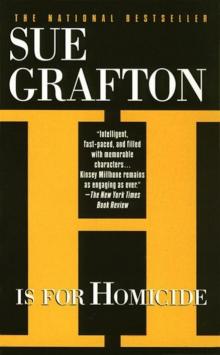 H Is for Homicide
H Is for Homicide X
X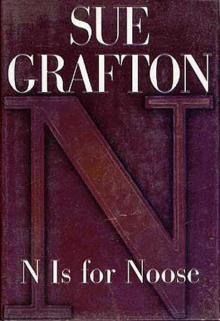 N Is for Noose
N Is for Noose Three Complete Novels: A Is for Alibi / B Is for Burglar / C Is for Corpse
Three Complete Novels: A Is for Alibi / B Is for Burglar / C Is for Corpse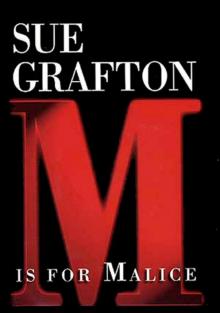 M Is for Malice
M Is for Malice I is for INNOCENT
I is for INNOCENT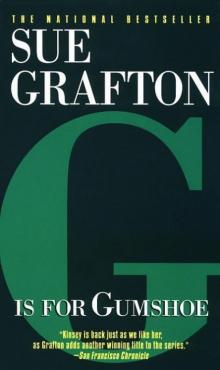 G is for GUMSHOE
G is for GUMSHOE K is for KILLER
K is for KILLER S is for SILENCE
S is for SILENCE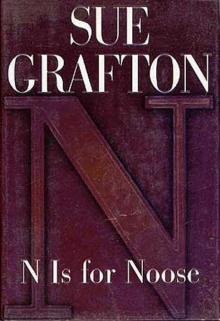 N is for NOOSE
N is for NOOSE D is for DEADBEAT
D is for DEADBEAT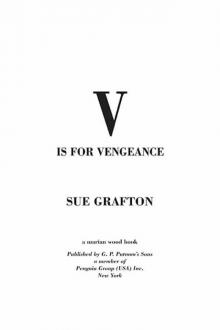 V is for Vengeance
V is for Vengeance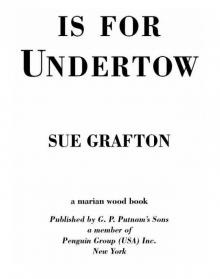 U is for Undertow
U is for Undertow W Is for Wasted km-23
W Is for Wasted km-23 O is for OUTLAW
O is for OUTLAW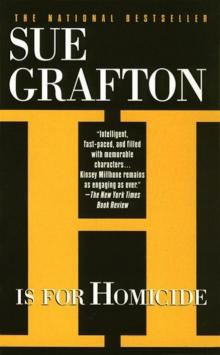 H is for HOMICIDE
H is for HOMICIDE Sue Grafton Novel Collection
Sue Grafton Novel Collection Kinsey and Me
Kinsey and Me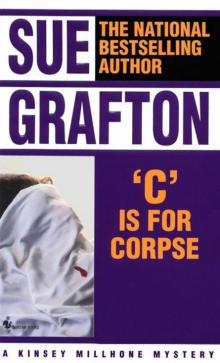 C is for CORPSE
C is for CORPSE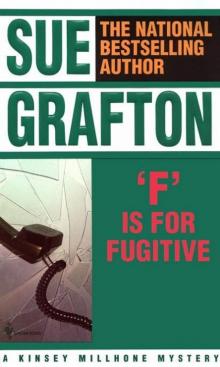 F is for FUGITIVE
F is for FUGITIVE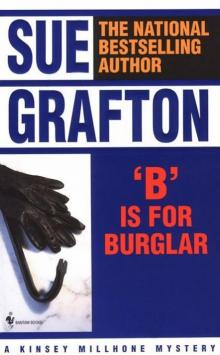 B is for BURGLAR
B is for BURGLAR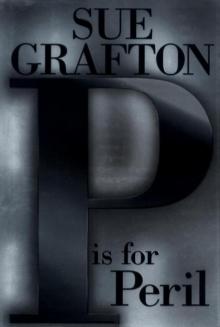 P is for PERIL
P is for PERIL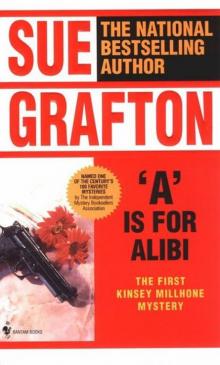 A is for ALIBI
A is for ALIBI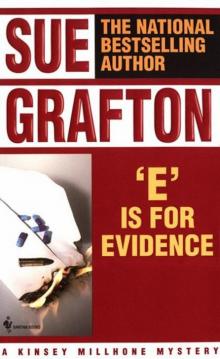 E is for EVIDENCE
E is for EVIDENCE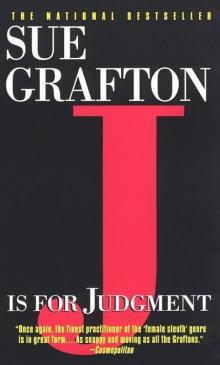 J is for JUDGMENT
J is for JUDGMENT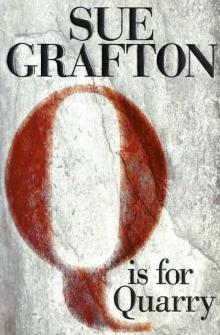 Q is for QUARRY
Q is for QUARRY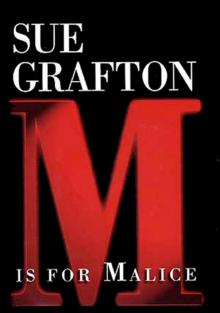 M is for MALICE
M is for MALICE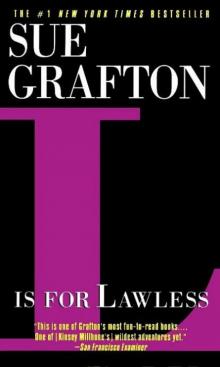 L is for LAWLESS
L is for LAWLESS